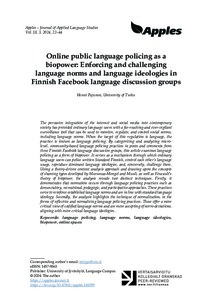Language learner identity and aptitude : a comparative study between Finnish and Chilean students and teachers of English
Laine, Charlotte (2019-04-30)
Language learner identity and aptitude : a comparative study between Finnish and Chilean students and teachers of English
Laine, Charlotte
(30.04.2019)
Julkaisu on tekijänoikeussäännösten alainen. Teosta voi lukea ja tulostaa henkilökohtaista käyttöä varten. Käyttö kaupallisiin tarkoituksiin on kielletty.
avoin
Julkaisun pysyvä osoite on:
https://urn.fi/URN:NBN:fi-fe2019052817607
https://urn.fi/URN:NBN:fi-fe2019052817607
Tiivistelmä
Language identity and language aptitude are individual traits closely related to the foreign language learner be it a student or a teacher. The aim of this study was to examine the relationship between these two concepts and how they vary between students and teachers respectively. A cultural component was added to ascertain whether the prevailing learning environment affects the outcome. The two subject groups either studied or taught English at an intermediate or higher level in Southwest Finland or Northern Chile. All of the participants (N = 62) were adults. A two-fold questionnaire was employed as the study method to gather data. The first part examined the subjects’ self-perceived language learner identity, while the second applied parts of the Pimsleur Language Aptitude Battery to obtain language aptitude scores for the subjects.
The language identity scores of the two subject groups were compared to each other using the Mann-Whitney U-test for independent samples. The same test was also used to compare the final language aptitude scores of the subjects. Spearman’s rank order correlation coefficient was applied in determining the interrelationship between the subjects’ language aptitude and language identity scores. All of these calculations were performed using SPSS Statistics.
The results revealed a difference between the language learner identities and language aptitudes of the subjects from the two different countries, indicating that the cultural background does have an effect. The results between students and teachers varied in relation to language identity, but not in reference to language aptitude. Similarly, a significant correlation was found between language identity and language aptitude in the case of the Finnish subjects, but not the Chilean subjects, warranting the need for further research into the interrelationship between these two concepts. Varying cultural contexts and their effect on the results should also be studied in the future.
The language identity scores of the two subject groups were compared to each other using the Mann-Whitney U-test for independent samples. The same test was also used to compare the final language aptitude scores of the subjects. Spearman’s rank order correlation coefficient was applied in determining the interrelationship between the subjects’ language aptitude and language identity scores. All of these calculations were performed using SPSS Statistics.
The results revealed a difference between the language learner identities and language aptitudes of the subjects from the two different countries, indicating that the cultural background does have an effect. The results between students and teachers varied in relation to language identity, but not in reference to language aptitude. Similarly, a significant correlation was found between language identity and language aptitude in the case of the Finnish subjects, but not the Chilean subjects, warranting the need for further research into the interrelationship between these two concepts. Varying cultural contexts and their effect on the results should also be studied in the future.
Samankaltainen aineisto
Näytetään aineisto, joilla on samankaltaisia nimekkeitä, tekijöitä tai asiasanoja.
-
Online public language policing as a biopower: Enforcing and challenging language norms and language ideologies in Finnish Facebook language discussion groups
Pajunen, Henni<p> The pervasive integration of the internet and social media into contemporary society has provided ordinary language users with a far-reaching and ever-vigilant surveillance tool that can be used to monitor, regulate, ... -
Association of language proficiency and leisure time language use among the children who speak Finnish as an additional language
Rahman, Habibur (07.06.2024)This study investigates the relationship between Finnish language proficiency and its use during leisure activities among children who speak Finnish as an additional language. Using data from the Finnish Education Evaluation ...avoin -
Spoken second language words activate native language orthographic information in late second language learners
Outi Veivo; Vincent Porretta; Jukka Hyönä; Juhani Järvikivi<p>This study investigated the time course of activation of orthographic information in spoken word recognition with two visual world eye-tracking experiments in a task where second language (L2) spoken word forms ...



